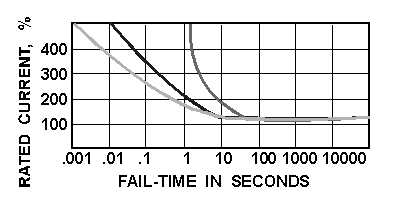2-9
Standard
Standard fuses have no built-in time delay. Also, they are not designed to be very fast acting.
Standard fuses are sometimes used to protect against direct shorts only. They may be wired in series with
a delay fuse to provide faster direct short protection. For example, in a circuit with a 1-ampere delay fuse,
a 5-ampere standard fuse may be used in addition to the delay fuse to provide faster protection against a
direct short.
A standard fuse can be used in any circuit where surge currents are not expected and a very fast
opening of the fuse is not needed. A standard fuse opens faster than a delay fuse, but slower than a fast
rated fuse.
Standard fuses can be used for automobiles, lighting circuits, or electrical power circuits.
Fast
Fast fuses are designed to open very quickly when the current through the fuse exceeds the current
rating of the fuse. Fast fuses are used to protect devices that are very sensitive to increased current. A fast
fuse will open faster than a delay or standard fuse.
Fast fuses can be used to protect delicate instruments or semiconductor devices.
Figure 2-7 will help you understand the differences between delay, standard, and fast fuses. Figure
2-7 shows that, if a 1-ampere rated fuse had 2 amperes of current through it, (200% of the rated value), a
fast fuse would open in about .7 second, a standard rated fuse would open in about 1.5 seconds, and a
delay rated fuse would open in about 10 seconds. Notice that in each of the fuses, the time required to
open the fuse decreases as the rated current increases.
Figure 2-7.—Time required for fuse to open.
Q11. In what three ways are fuses rated?
Q12. What does the current rating of a fuse indicate?
Q13. What does the voltage rating of a fuse indicate?
Q14. What are the three time delay ratings of fuses?
Q15. Give an example of a device you could protect with each type of time delay fuse.


